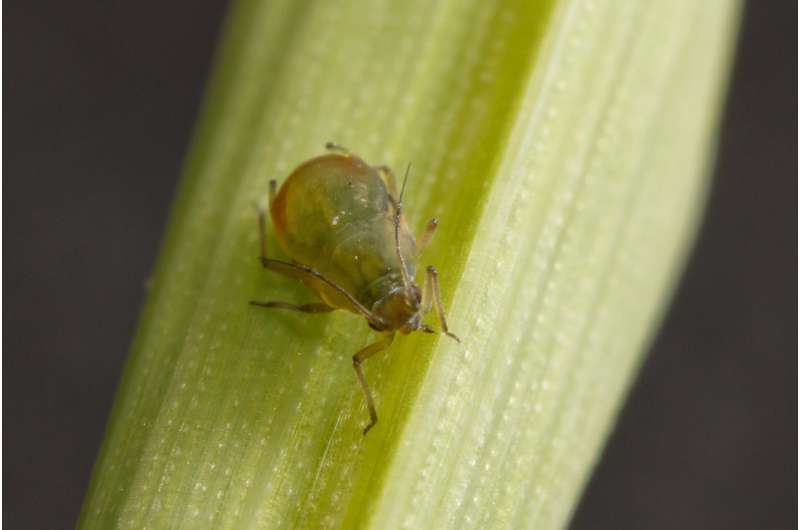Plant virus alters competition between aphid species

In the world of plant-feeding insects, who shows up first to the party determines the overall success of the gathering; yet viruses can disrupt these intricate relationships, according to researchers at Penn State.
"We found further evidence that viruses manipulate more advanced organisms to improve their own fitness," said Mitzy Porras, a recent doctoral graduate in entomology, working with Tomas Carlo, associate professor of biology, and Ed Rajotte, professor of entomology." In other words, their ability to pass on their genome to the next generation of viruses."
Porras and her colleagues studied the order of arrival of two species of aphids to wheat plants.
"Species that share the same limiting resource—in this case wheat plants—normally are expected to compete with each other for that resource," she said. "But we found that the order of arrival to the host plant affects the outcome of the ecological interactions."
Porras explained that in the absence of viruses, the aphid species Rhopalosiphum padi typically is the first to invade wheat plants, while Rhopalosiphum maidis arrives later. If the opposite occurs—R. maidis arrives first—then the success of R. padi is hindered. However, when R. padi infects the plant with barley yellow dwarf virus (BYDV), two things change: the success of late-arriving R. maidis increases and, if R. maidis arrives first, then late-arriving R. padi has no trouble colonizing the plant.
"The virus increases nutrients in the plant, including sugars, sterols and amino acids, and may change the anatomy of the plant's leaves, making the leaves easier for aphids to find and access the nutritious sap," said Porras. "The aphids end up feeding for longer periods of time, which results in boosted reproductive success. The better the aphids do, the higher the probability that they will spread the virus to the host plant and to other aphids."
The findings appeared recently in Scientific Reports.
Porras and her colleagues designed a set of field and laboratory experiments in which they manipulated the presence of virus strains within aphids, along with the order of aphid species arrival to wheat plants. They recorded the time it took for the aphids to start feeding, the duration of feeding and the reproductive health of the aphids. They also examined how aphid foraging affected the nutritional quality of host plants and plant virus strains.
"We placed electronic micro-sensors on individual insects and plants to measure feeding events with precision," said Porras. "Specifically, we measured two key parameters of aphid foraging—the time taken by aphids to reach the phloem (the nutritious plant sap), and the duration of ingestions."
The team extracted viruses from plants, and used ELISA tests—which detect specific antibodies—to identify the types of viruses within the plants. In addition, they used a variety of gas chromatography and mass spectrometry techniques to analyze the plants for nutrient content.
"We learned that viruses play an important role in changing the nature of the interactions between and among species," said Porras. "It's fascinating that something as small as a virus with such a simple genome can manipulate more advanced organisms for its own benefit."
More information: Mitzy Porras et al, A plant virus (BYDV) promotes trophic facilitation in aphids on wheat, Scientific Reports (2018). DOI: 10.1038/s41598-018-30023-6
Journal information: Scientific Reports
Provided by Pennsylvania State University





















